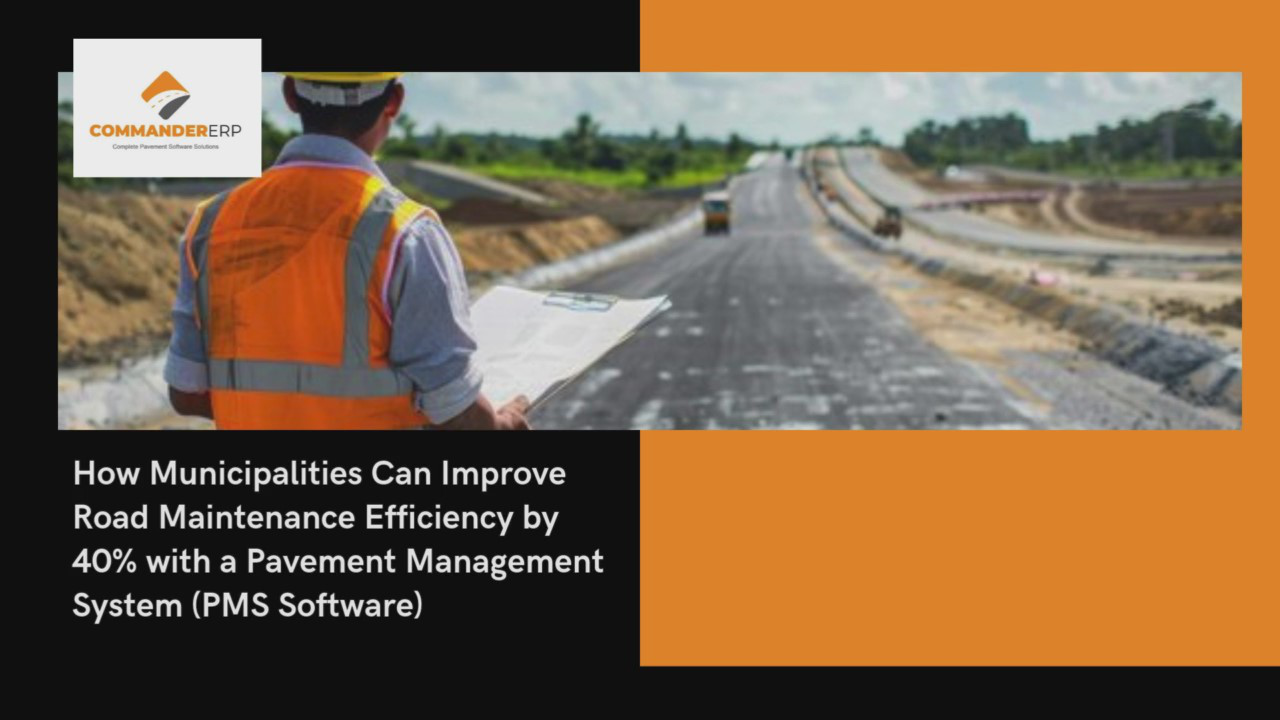
x
c
o
m
m
a
n
d
e
r
e
r
p
Blog
- Home
- Blog
- Commander ERP
- 2025-08-29
How Municipalities Can Improve Road Maintenance Efficiency by 40% with a Pavement Management System (PMS Software)
Smarter Road Asset Management for Municipalities
Roads are the backbone of every community. They connect people to schools, businesses, hospitals, and essential services. Yet, maintaining them is one of the biggest challenges for municipalities.
Traditionally, road maintenance follows a reactive approach, fixing cracks and potholes only when they become a visible problem. While this may solve immediate issues, it often leads to frequent disruptions, shorter pavement lifespans, and rising citizen complaints.
Today, forward-thinking municipalities are adopting Pavement Management Systems (PMS) to overcome these challenges. Studies show that by using a PMS, cities can achieve up to 40% improvement in efficiency and road performance, all while extending pavement life cycles and improving public satisfaction.
The Problem with Traditional Road Maintenance (Infrastructure Management Challenges)
Without structured planning, municipalities often fall into a cycle of “fix as you go.” This creates several challenges:
-
Accelerated Deterioration: A road left untreated will deteriorate much faster, requiring heavier interventions later.
-
Unplanned Disruptions: Emergency repairs create sudden road closures, frustrating commuters and businesses.
-
Inefficient Resource Use: Crews, equipment, and materials are often dispatched reactively, leading to wasted effort.
-
Difficulty in Prioritization: With limited data, decisions on which road to repair first are often made based on complaints or political influence rather than actual need.
This approach not only decreases pavement quality but also makes long-term planning nearly impossible. Municipalities remain in constant firefighting mode, which leaves little room for strategic improvements.
What is a Pavement Management System (Road Asset Management Software)?
A Pavement Management System (PMS) is a specialized software solution that helps municipalities plan, prioritize, and optimize road maintenance activities using data-driven insights.
Instead of guesswork, PMS relies on science, analytics, and predictive modeling to guide decision-making.
Key functions of PMS include:
-
Condition Assessment: Pavement health is measured using metrics such as the Pavement Condition Index (PCI), which provides a standardized score for every road segment.
-
Predictive Modeling: PMS forecasts how each road will deteriorate over time, enabling early interventions before damage escalates.
-
Prioritization Tools: Roads are ranked based on urgency, traffic load, and lifecycle value, ensuring the right roads are maintained at the right time.
-
GIS Mapping: Visual dashboards provide a map-based overview of the entire network, allowing managers to see real-time pavement conditions.
-
Maintenance Planning: PMS generates proactive maintenance schedules, ensuring crews work more efficiently and consistently.
How PMS Improves Municipal Road Management by Up to 40%
PMS doesn’t just digitize road data, it transforms the way municipalities maintain infrastructure. Let’s break down how PMS delivers measurable improvements:
1. Proactive vs. Reactive Maintenance (Preventive Road Maintenance)
In traditional methods, municipalities wait until damage becomes severe before acting. PMS changes this by identifying issues early and suggesting preventive measures such as sealing, resurfacing, or minor overlays.
This approach can extend pavement life by over 40%, since preventive treatments stop minor cracks from developing into full-scale failures. Instead of resurfacing roads every 10 years, municipalities can extend their lifespan to 14–15 years with planned interventions.
2. Smarter Decision-Making (Data-Driven Road Planning)
One of the biggest strengths of PMS is evidence-based prioritization. Instead of repairing roads based on citizen complaints or political agendas, decisions are made using PCI scores, deterioration models, and traffic analysis.
This improves planning accuracy by up to 35%, ensuring that roads with the greatest need or highest usage are always addressed first. It also helps municipalities defend decisions when questioned by councils, auditors, or the public.
3. Data-Driven Forecasting (Long-Term Pavement Planning)
Reactive maintenance makes it nearly impossible to plan beyond the next repair cycle. PMS solves this by offering multi-year forecasting.
For example, a municipality can simulate how its road network will look in 5, 10, or 20 years based on different maintenance strategies. This ensures continuity in planning, smoother budgets, and 25–30% fewer emergency interventions because deterioration is anticipated well in advance.
4. Optimized Resource Allocation (Efficient Road Asset Management)
Resource management is another area where PMS drives significant efficiency. By mapping road conditions, predicting work volumes, and scheduling tasks digitally, municipalities can use crews, machinery, and materials more effectively.
The result is 20–30% higher efficiency in field operations. Crews spend less time traveling between unplanned repair sites and more time executing scheduled, high-impact maintenance activities.
A Real-World Scenario (Case Study: Municipal Road Management System)
Imagine a mid-sized city responsible for 800 miles of pavement. Without PMS, the city responds mainly to complaints and visible deterioration. Roads are either over-maintained (spending resources on roads that don’t need attention yet) or under-maintained (ignoring roads until failure).
After implementing a Pavement Management System like Commander ERP:
The city extends pavement life cycles by up to 40%, maximizing network performance.
Scheduled maintenance reduces traffic disruptions by 30%, since emergency repairs become less frequent.
City councils gain access to clear, transparent reports showing exactly why certain roads are prioritized.
Residents experience smoother commutes, fewer potholes, and visibly better road conditions.
This scenario illustrates how PMS provides both technical advantages and public-facing benefits, making it a win-win for all stakeholders.
Beyond Road Conditions: Wider Benefits of PMS (Sustainable Infrastructure Management)
The benefits of PMS reach far beyond pavement itself. Municipalities adopting PMS see improvements across multiple dimensions:
-
Improved Road Safety: Roads treated proactively have fewer hazards, reducing accidents and improving traffic flow.
-
Greater Transparency: With dashboards and reports, municipalities can communicate clearly with councils, auditors, and citizens.
-
Sustainability: Proactive maintenance reduces unnecessary reconstruction projects, lowering carbon emissions and material waste.
-
Higher Citizen Satisfaction: Residents notice smoother roads and fewer disruptions, which strengthens trust in local government.
Conclusion: The Future of Pavement Management Systems (Commander ERP PMS Solution)
The old way of managing roads, reactive maintenance, political prioritization, and endless emergency fixes, is no longer sustainable. Municipalities that adopt a Pavement Management System can expect up to 40% improvement in efficiency, longer pavement lifespans, and better citizen experiences.
Commander ERP’s Pavement Management System empowers municipalities to embrace this future by combining advanced analytics, GIS mapping, and predictive models into one powerful platform. The result is smarter planning, more efficient execution, and safer roads for everyone.
It’s time to stop firefighting and start future-proofing municipal infrastructure.



